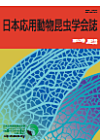All issues

Volume 53 (2009)
- Issue 4 Pages 135-
- Issue 3 Pages 77-
- Issue 2 Pages 45-
- Issue 1 Pages 1-
Volume 53, Issue 2
Displaying 1-12 of 12 articles from this issue
- |<
- <
- 1
- >
- >|
Regular Papers
-
Kiyomitsu Ito, Katsuhiro FurukawaArticle type: Original Article
2009Volume 53Issue 2 Pages 45-51
Published: May 25, 2009
Released on J-STAGE: June 02, 2009
JOURNAL FREE ACCESSThe effectiveness of insecticide-free cultivation for controlling the direct sucking damage of aphids in the potato field was investigated for five years under field conditions in Hokkaido, Japan. In the field plot without insecticide application, indigenous predators, such as ladybirds, minute pirate bugs, lace wings and syrphid flies, were observed and there were no outbreaks of Aphis gossypii (or other aphid species); i.e., the density of A. gossypii did not exceed 10 insects per compound leaf. Furthermore, there were no other harmful insect pests. As a result, both the tuber yield and starch value were comparable to those in the insecticide-treated plot. There were no differences in these findings by year, region, or potato cultivar.View full abstractDownload PDF (240K)
Notes
-
Fumiaki Mochizuki, Yumi Aoki, Hajime Sugie, Jun Tabata, Akihiko Takaha ...Article type: Short Communication
2009Volume 53Issue 2 Pages 53-56
Published: May 25, 2009
Released on J-STAGE: June 02, 2009
JOURNAL FREE ACCESSPupae of the bean webworm, Pleuroptya ruralis, were collected from soybean fields in Toyama and Niigata, and the sex pheromone glands were removed from 24 virgin females that emerged from the pupae. The extract from sex pheromone glands was analyzed by GC-EAD and GC-MS, and then (E)- and (Z)-10-hexadenal were realized as candidates of the sex pheromones. Forty-five feral males were captured with a white sticky trap baited with an 84 : 16 mixture of (E)- and (Z)-10-hexedecenal from 14 to 29 July 2005 in Toyama. These results suggest that the mixture of aldehydes is a sex attractant of the bean webworm.View full abstractDownload PDF (332K) -
Toshinori Kichishima, Maki Fukuyama, Hiroya Higuchi, Akihiko Takahashi ...Article type: Short Communication
2009Volume 53Issue 2 Pages 57-59
Published: May 25, 2009
Released on J-STAGE: June 02, 2009
JOURNAL FREE ACCESSIn order to examine the daily periodicity of the attraction of males to females in the sorghum plant bug, Stenotus rubrovittatus, males captured on sticky traps baited with 10 virgin females were investigated every four hours. Male bugs were captured in traps, but the number of males captured was none or few from noon to four o'clock in the afternoon in a day. This result suggests the daily periodicity of attraction of males to females. To examine the daily periodicity of mating, thirty pairs of virgin adults six days after emergence were released into a rearing cage in the laboratory at different times of day. The number of mated females was checked 4 h later. The percentage of mated females did not differ regardless of the time of release and the light conditions. This result suggests that there is no daily periodicity in mating.View full abstractDownload PDF (265K) -
Kiyohisa Kawamura, Suguru Ohno, Dai Haraguchi, Tsuguo KohamaArticle type: Short Communication
2009Volume 53Issue 2 Pages 60-63
Published: May 25, 2009
Released on J-STAGE: June 02, 2009
JOURNAL FREE ACCESSTo establish a simple method for discriminating Okinawa and Ogasawara strains of the sweet potato weevil, Cylas formicarius, about 560 bp of the internal transcribed spacer-1 (ITS-1) region of the ribosomal DNA (rDNA) of C. formicarius was collected from several islands of Okinawa Prefecture and Ogasawara Islands and analyzed by polymerase chain reaction-restriction fragment length polymorphism (PCR-RFLP). The 345 weevils collected in Okinawa and Ogasawara were discriminated correctly by the RFLP patterns with the restriction enzyme RsaI. The results suggest that C. formicarius originating from Ogasawara Islands is an effective genetic marking strain for an eradication project using the sterile insect technique implemented by the Okinawa prefectural government.View full abstractDownload PDF (443K)
-
2009Volume 53Issue 2 Pages 64-67
Published: May 25, 2009
Released on J-STAGE: June 02, 2009
JOURNAL FREE ACCESSDownload PDF (365K) -
2009Volume 53Issue 2 Pages 68-73
Published: May 25, 2009
Released on J-STAGE: June 02, 2009
JOURNAL FREE ACCESSDownload PDF (815K) -
2009Volume 53Issue 2 Pages 74
Published: May 25, 2009
Released on J-STAGE: June 02, 2009
JOURNAL FREE ACCESSDownload PDF (41K) -
2009Volume 53Issue 2 Pages 75
Published: May 25, 2009
Released on J-STAGE: June 02, 2009
JOURNAL FREE ACCESSDownload PDF (79K) -
2009Volume 53Issue 2 Pages C21
Published: May 25, 2009
Released on J-STAGE: June 02, 2009
JOURNAL FREE ACCESSDownload PDF (38K) -
2009Volume 53Issue 2 Pages H23
Published: May 25, 2009
Released on J-STAGE: June 02, 2009
JOURNAL FREE ACCESSDownload PDF (47K) -
2009Volume 53Issue 2 Pages H22
Published: May 25, 2009
Released on J-STAGE: June 02, 2009
JOURNAL FREE ACCESSDownload PDF (139K) -
2009Volume 53Issue 2 Pages H21
Published: May 25, 2009
Released on J-STAGE: June 02, 2009
JOURNAL FREE ACCESSDownload PDF (184K)
- |<
- <
- 1
- >
- >|